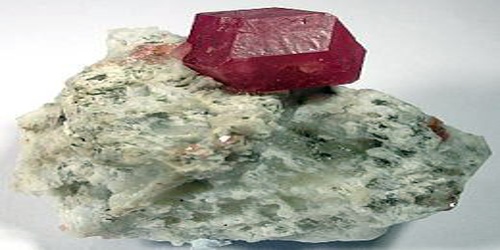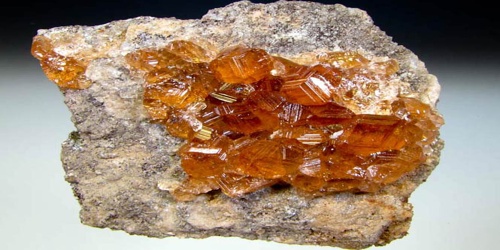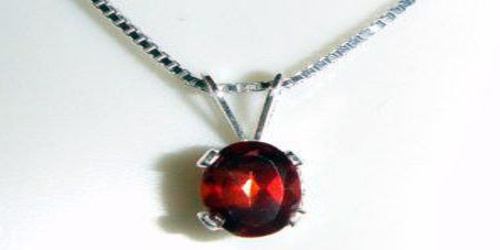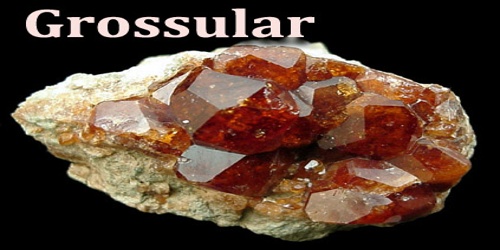Grossular
Definition
Grossular is the calcium aluminum garnet and forms in contact or regional metamorphic environments as does andradite the calcium iron garnet. It is believed that these garnets form from the metamorphism of impure siliceous limestones. The name grossular is derived from the botanical name for the gooseberry, grossularia, in reference to the green garnet of this composition that is found in Siberia. Other shades include cinnamon brown (cinnamon stone variety), red, and yellow.

Grossular is a gemstone. Originally named “cinnamon stone” (“Kanelstein” in German) in 1803 by Abraham Gottlob Werner and renamed grossularite by Werner in 1808. Named for the color of gooseberries (Ribes grossularium) as the original specimens were this color.
In geological literature, grossular has often been called grossularite. Since 1971, however, use of the term grossularite for the mineral has been discouraged by the International Mineralogical Association.
As a potent prosperity stone, Grossular Garnet is healing of all limitations on the physical level, in health or wealth. Green Garnet carries an especially regenerative energy, and is excellent for those who’ve had money problems and wish to reform. As a stone of strength, Grossular Garnet will benefit new business ventures, promoting growth and warm client contact. It strengthens stability in lawsuits and challenges, transforming lower forms of response and reaction to loving forms of reply.
Production and Types of Grossular Garnets
Grossular is found in contact metamorphosed limestones with vesuvianite, diopside, wollastonite and wernerite. A highly sought after variety of gem garnet is the fine green Grossular garnet from Kenya and Tanzania called tsavorite. This garnet was discovered in the 1960s in the Tsavo area of Kenya, from which the gem takes its name.
Grossular is also known by many other names, and also some misnomers; colophonite – coarse granules of garnet, ernite, gooseberry-garnet – light green colored and translucent, olyntholite/olytholite, romanzovite, and tellemarkite. Misnomers include South African jade, garnet jade, Transvaal jade, and African jade.

- Hessonite (Cinnamon Stone) – orange to dark brown-orange and reddish-brown crystal; relatively rare. Hessonite is called the Cinnamon Stone, not only for its color, but because of the land of spices where it originated–Ceylon, now called Sri Lanka. It brings success in self-initiated businesses based on an original idea or unfilled market niche, and inspires and brings out artistic expression, even in the seemingly untalented. Associated with the Sacral Chakra, It promotes self-respect and clarity of emotions, and soothes emotional agitation.
- African Green Garnet (African Jade) – from Mali; green crystals helpful for bringing one’s visions into reality. Their vibrational pattern creates confidence and motivation to get down to business and make things happen. This stone encourages prosperity, healing the root of scarcity-mindedness, and reveals the abundance the Earth and Universe provide. It is attuned to the Heart Chakra.
- Tsavorite – pale to emerald green; rare. Tsavorite is the name used most frequently in the USA. In Europe it is called tsavolite. It is restorative and freeing, bringing new strength in difficult phases of life. From Kenya, this gem-grade Garnet is the most energetically focused of the Grossular varieties. It is a stone of wealth in all its positive aspects–financial, creative, emotional, artistic and even physical health. It can open and cleanse the Heart Chakra, increasing zest and vitality, and inducing feelings of charity and benevolence. Tsavorite can also transmit its qualities through the eyes of anyone who sees it, so wearing it in the workplace uplifts everyone who comes in contact.

Properties and Applications of Grossular
Grossular forms a solid solution series with Andradite, and can be virtually indistinguishable from it in localities where they both occur together. Grossular is named for its color resemblance to gooseberries, which are scientifically known as ribes grossularium. Its chemical formula: Ca3Al2Si3O12, and variable formula: Ca3(Al,Fe3+,Mn,Cr)2Si3O12. It is usually in sharp dodecahedral crystals and dense dodecahedral aggregates. Crystals often have growth patterns, etchings, and striations. Occasionally in trapezohedral crystal or trapezohedral-dodecahedral modifications. Also massive and in dense growths of tiny crystals.

Grossular Garnet is an excellent crystal to soothe and reduce emotional extremes, encouraging social growth and service to community. Grossular Garnet physical healing properties include aiding in recovery of illness or trauma by regenerating new cell growth and stimulating the blood. It also detoxifies and alleviates inflammations throughout the body and boosts the immune and respiratory system.
It honors three Goddesses, and a vast number of Angels are drawn to its myriad color energies, from lush green rays to the warmest shades of the sun. Garnet is the traditional birthstone of January, and because of its various hues, Grossular Garnet is the natural birthstone of many born from early spring to mid-autumn. Garnet is the zodiac stone for those born under the sign Aquarius, and is an Enhancer Strengthener crystal. Grossular Garnet has the properties of Wood and Fire energies, and is a talisman to attract abundance, joy and health.
Reference:
















